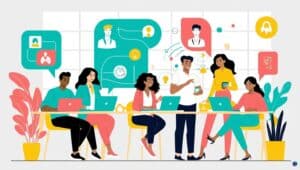
Image Source: FreeImages
Introduction to generational differences in the workplace
As the workforce continues to evolve, organizations are faced with the challenge of managing a diverse range of generations, each with its unique set of values, work styles, and communication preferences. In 2024, the workplace will be a melting pot of Baby Boomers, Generation X, Millennials, and Generation Z, all working together towards common goals. Navigating these generational differences can be a daunting task, but embracing diversity and fostering an inclusive environment is crucial for success.
The generational divide in the workplace is not a new phenomenon, but it has become increasingly prominent as the workforce has become more diverse. Each generation has been shaped by different societal, economic, and technological factors, resulting in varying perspectives and approaches to work. Understanding these differences and finding ways to bridge the gap is essential for creating a harmonious and productive work environment.
Understanding the different generational cohorts
To effectively navigate generational differences, it is crucial to understand the unique characteristics and values of each cohort:
Baby Boomers (born between 1946 and 1964): This generation values hard work, loyalty, and respect for authority. They often prioritize job security and are known for their strong work ethic.
Generation X (born between 1965 and 1980): This cohort is characterized by their independence, adaptability, and skepticism towards authority. They value work-life balance and are technologically savvy.
Millennials (born between 1981 and 1996): Often referred to as the “digital natives,” Millennials are tech-savvy, value collaboration, and seek meaningful work. They prioritize flexibility and work-life integration.
Generation Z (born after 1997): The youngest generation in the workforce, Gen Z is highly entrepreneurial, socially conscious, and deeply connected to technology. They value diversity, inclusivity, and transparency in the workplace.

Challenges arising from generational differences in the workplace
While generational diversity can bring a wealth of perspectives and experiences to an organization, it can also lead to challenges if not managed effectively:
- Communication barriers: Different generations may have varying communication styles and preferences, leading to misunderstandings and miscommunication.
- Conflicting work values: Each generation has different priorities and values when it comes to work, which can lead to conflicts and tensions.
- Resistance to change: Older generations may be more resistant to change and new technologies, while younger generations may be more open to innovation and disruption.
- Knowledge transfer: Ensuring effective knowledge transfer between generations can be challenging, as older workers may be reluctant to share their expertise, and younger workers may be perceived as lacking experience.
The impact of technology on generational differences
Technology has played a significant role in shaping generational differences in the workplace. While younger generations are often considered “digital natives,” older generations may struggle to adapt to rapidly changing technologies. This can lead to frustrations and a perceived lack of competence, which can negatively impact productivity and morale.
However, technology can also be a powerful tool for bridging the generational gap. By leveraging digital tools and platforms for communication, collaboration, and knowledge sharing, organizations can create an environment that caters to the preferences and strengths of different generations.
Bridging the gap between generations for success
To foster a successful and harmonious multi-generational workplace, organizations must proactively address generational differences and implement strategies to bridge the gap:
Promote open communication: Encourage open and respectful dialogue between generations, creating opportunities for individuals to share their perspectives and learn from one another.
Provide training and development: Offer training and development programs that cater to the diverse needs and learning styles of different generations, ensuring that everyone has access to the tools and knowledge they need to succeed.
Leverage mentorship programs: Implement mentorship programs that facilitate knowledge transfer and foster mutual understanding between generations. These programs can help younger workers learn from the experience of their older colleagues, while also providing opportunities for older workers to gain insights into the perspectives and skills of younger generations.
Embrace flexibility: Adopt flexible work arrangements and policies that accommodate the diverse needs and preferences of different generations, promoting work-life balance and employee satisfaction.
Celebrate diversity: Foster an inclusive culture that celebrates diversity and encourages collaboration and teamwork across generations, leveraging the unique strengths and perspectives of each cohort.
Strategies for effective communication across generations
Effective communication is crucial for bridging the generational gap and fostering a productive and harmonious work environment. Here are some strategies to consider:
Adapt communication styles: Be mindful of different communication preferences and adapt your style accordingly. For example, older generations may prefer face-to-face or written communication, while younger generations may be more comfortable with digital channels like instant messaging or video conferencing.
Use clear and concise language: Avoid jargon or generational slang that may be unfamiliar to others. Use clear and concise language to ensure that your message is understood by all.
Encourage active listening: Promote active listening skills across generations, encouraging individuals to be present, attentive, and respectful of differing perspectives.
Leverage technology: Utilize technology to facilitate communication and collaboration across generations. For example, video conferencing tools can help bridge the physical distance between remote workers, while collaboration platforms can enable real-time document sharing and editing.
Foster an environment of respect: Cultivate an environment of mutual respect and understanding, where individuals feel comfortable expressing their opinions and ideas without fear of judgment or dismissal based on their age or generation.
Promoting collaboration and teamwork in a multi-generational workplace
Collaboration and teamwork are essential for organizational success, and fostering a collaborative environment that embraces generational diversity can yield numerous benefits:
Leverage diverse perspectives: Encourage cross-generational teams to leverage the diverse perspectives, experiences, and skills of each generation, leading to more innovative and well-rounded solutions.
Facilitate knowledge sharing: Create opportunities for knowledge sharing and mentorship, allowing team members to learn from one another and ensuring that valuable expertise is not lost as older workers retire.
Foster mutual understanding: Encourage open dialogue and team-building activities that promote mutual understanding and appreciation for the unique strengths and contributions of each generation.
Embrace complementary skills: Recognize that each generation brings complementary skills and strengths to the table, and leverage these to create well-rounded and high-performing teams.
Celebrate collective achievements: Acknowledge and celebrate the collective achievements of multi-generational teams, reinforcing the value of collaboration and fostering a sense of unity and shared purpose.
Embracing diversity and inclusion in the workplace
Generational diversity is just one aspect of the broader diversity and inclusion landscape in the workplace. To truly foster an inclusive and equitable environment, organizations must embrace diversity in all its forms, including but not limited to age, gender, race, ethnicity, sexual orientation, and ability.
By embracing diversity and promoting inclusivity, organizations can benefit from a wider range of perspectives, experiences, and ideas, leading to increased innovation, creativity, and problem-solving capabilities. Additionally, a diverse and inclusive workplace can enhance employee engagement, job satisfaction, and overall organizational performance.
Adapting leadership styles to cater to different generations
Effective leadership is crucial for navigating generational differences and fostering a productive and harmonious work environment. Leaders must adapt their styles and approaches to cater to the diverse needs and preferences of different generations:
Adopt a flexible leadership style: Embrace a flexible and adaptable leadership style that can accommodate the varying needs and preferences of different generations. Be open to adjusting your approach based on the unique dynamics and composition of your team.
Leverage different communication channels: Utilize a variety of communication channels to ensure that your message reaches all generations effectively. For example, younger generations may prefer digital channels, while older generations may prefer more traditional methods like face-to-face meetings or written memos.
Provide clear direction and support: While some generations may value autonomy and independence, others may require more guidance and support. Tailor your leadership approach to provide the appropriate level of direction and support based on the needs of your team members.
Foster a culture of continuous learning: Encourage a culture of continuous learning and development, providing opportunities for team members of all generations to acquire new skills and knowledge. This not only promotes personal and professional growth but also facilitates knowledge transfer across generations.
Lead by example: Demonstrate a commitment to diversity, inclusion, and respect for all generations. Lead by example and create an environment where individuals feel valued and appreciated for their unique contributions, regardless of their age or generation.
The future of generational differences in the workplace in 2024
As we look towards 2024, the generational landscape in the workplace will continue to evolve. Generation Z will become a more prominent presence, bringing their unique perspectives, values, and technological savvy to the workforce.
Organizations that proactively address generational differences and foster an inclusive and collaborative environment will be better positioned to attract and retain top talent across all generations. Embracing diversity and leveraging the unique strengths and perspectives of each generation will be crucial for driving innovation, creativity, and organizational success.
Additionally, the impact of technological advancements and changing societal norms will continue to shape the dynamics of generational differences in the workplace. Organizations must remain agile and adaptable, continuously reassessing their strategies and approaches to ensure they remain relevant and effective in navigating the evolving generational landscape.
Conclusion: Embracing diversity for a successful future
Navigating generational differences in the workplace is a complex and ongoing challenge, but it is one that organizations must embrace to remain competitive and successful in the ever-changing business landscape. By fostering an inclusive and collaborative environment that celebrates diversity and leverages the unique strengths and perspectives of each generation, organizations can create a harmonious and productive workplace that drives innovation, creativity, and overall organizational success.
As we look towards 2024 and beyond, it is crucial for organizations to prioritize diversity and inclusion as a strategic imperative. Embracing generational differences is just the beginning; organizations must also actively promote diversity in all its forms, including gender, race, ethnicity, sexual orientation, and ability.
By creating a workplace that values and respects individuals from all backgrounds and generations, organizations can tap into a rich pool of talent, ideas, and perspectives, positioning themselves for long-term success in an increasingly diverse and globalized world.











